Anterior Pelvic Tilt (APT) is becoming more and more of an epidemic among both fit and sedentary individuals. For some this cumulative issue is causing irritation to what are already herniated discs, ruptures, facet joint issues and lower back muscle tightness all leading to one thing, back pain. I have been to 3 different spine specialists for my own damage and not one of them pointed out my obvious Anterior Pelvic Tilt. A few $1,000 later, I was still dealing with back pain. The problem with most sources you find on the interwebs is they only address one aspect of fixing this issue for good. I am going to give you a complete guide to testing and defeating the infamous Anterior Pelvic Tilt aka “Duck Butt” for good.
I don’t know what it is with some people. There is a clear connection between the front of the body and the back of the body when it comes to the cause and treatment of Anterior Pelvic Tilt. Nobody seems to care about treating the body as a linked chain rather then cemented parts. Don’t get me wrong, I made this mistake for a while until finally making the connection and putting the work in to fix it.
Some of the tools I use on a daily bases are located in this article as affiliate links.
Lets dive in.
What exactly is Anterior Pelvic Tilt?
Anterior pelvic tilt is basically the imbalance of muscles located in and around the hip both in the front (anterior) portion of the trunk and the back (posterior). Usually what you see in a classic APT case is a shortening of the muscles in the front and a lack of control and lengthening of the muscles in the back. Just like making babies and salsa dancing, it takes two to tango. We can’t just look at the hip flexors and quads when it comes to addressing Anterior Pelvic Tilt. We need to show just as much attention to muscles like the glutes, Hamstrings, Quadratus Lumborum (QL), Erector Spinae and Multifidus as we do the Iliopsoas and Rectus Femurs (hip flexor) on the front of the body. I Know, your probably like WHOA ease up on the laboratory talk. Bare with me this is all going to make sense.
Lets start with some pictures.
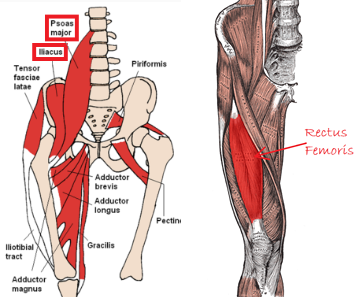
Lets first address the Psoas and Rectus Femoris.
Note the highlighted Psoas Major and Rectus Femoris. These are two of the guys responsible for your chronic back pain and Anterior Pelvic Tilt. When these guys get shortened from let’s say; too much sitting, the tension yanks down on the pelvis and causes a tilting affect. Most resources will say hammer these muscles with stretches and foam rolling and your pain will magically disappear. Unfortunately, that isn’t the full story. Yes, stretching those muscles WILL help but there is a bigger picture you have to see.
The part most miss when fixing anterior pelvic tilt
On the opposite side of the leg we have some muscles who’s job is to work in line with the muscles on the front of the leg. Because of this much-needed balance, if muscles on the front of the leg become too dominate and start taking over, there is always a group of muscles on the opposite side that usually suffer.
Insert the hamstring and glutes.
With this chronic tension and shortening in the Psoas and Rectus Femoris the hamstrings are being pulled into a stretch. On-top of that, your glutes are failing at being activated to help keep the pelvis inline and stable. Because of this constant tension on the hamstrings, it gives the illusion that they are over tight to the point of feeling like they need to be stretched. The crazy thing is, someone with this issue would actually fail a hamstring flexibility test. Which to the average coach would mean stretch the hamstrings but that’s not the solution. The tight hamstrings are due to the tension the Anterior Pelvic Tilt is creating. So, the wrong answer to fixing APT would be to simply stretch the hamstrings and stretch the hip flexors.
That’s not all…
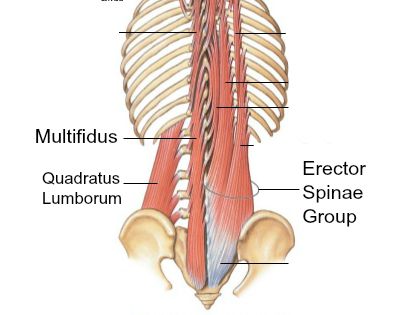
We still have the Quadratus Lumborum, Erector Spinae and Multifidus that we have to address. Unfortunately, these muscles get thrown into the pile involuntarily. Because of the pelvic tilt the lower back muscles get shortened and tight from this constant lordotic posture. In some cases, you may have been in this tilted position so long that simply stretching the “lower back muscles” causes even more irritation. Some times (not all of the time) simply correcting proper standing posture and pelvic position along with addressing the hip flexors, glutes and hamstrings will help reduce the sensitivity in these lower back muscles which will slowly begin to release and relax. In other cases, a little attention with a Lacrosse Peanut Ball or Thera-Cane will be needed to help release these muscles as well.
How does Anterior Pelvic Tilt Cause Back Pain?
Like I always say. When dealing with back pain it’s a cumulative issue that stretches over variety of different things. For the sake of this article lets just assume your back pain is caused by Anterior Pelvic Tilt. This is typically how it would play out.
Years and years of being in this default Anterior Pelvic Tilt position paired with faulty movement patterns such as posture while sitting, posture while standing and if you exercise the compounding effects of loading your spine with this pelvic position have all played a major role in the way your lower back feels today. For me, this Anterior Pelvic Tilt has caused more irritation to what is already a ruptured L5-S1 disc. Since I went so long without addressing this APT along with the years and years of doing lifts such as Squats and Deadlifts have not only made the area more inflamed and damaged but it started to affect my facet joints which is a whole other issue.
You may not be where I was so if you have no damage and you seem to be experiencing lower back tightness a long with this feeling of being in over extension after standing for a while, your APT is not only constantly pulling on your hamstrings which causes irritation but your pelvis isn’t aligned so your body weight can’t be distributed the way it should over your hips, glutes and lower body. Because of this, your lower back becomes the catch all for all faulty movement and loads. Pair that with some over tight lower back muscles and you’re a perfect candidate for chronic back pain.
Seems simple right?
Well, a lot of back pain is simple to fix it’s just finding your root cause and having the patience and determination to fix it once you find it is where it gets sticky.
How to Identify Anterior Pelvic Tilt
There really isn’t a sure fire way of diagnosing Anterior Pelvic Tilt. In a clinical setting, there are standardized numbers, formulas, and calipers they can use. If you want to spend buckets of money seeing a specialist just to do what you can do at home, be my guest. If you’re looking to get this done at home it can be easily done using images and lines showing a tilt in the pelvis. If you’re looking to diagnosis your self, the easiest tool that I use is a simple camera and line drawing tool you can easily find in a basic photo viewing program on your computer.
The point of contacts for measuring Anterior Pelvic Tilt (APT).
The reference points are we looking at in the picture above are the Anterior Superior Iliac Spine (also known as the ASIS or front bony thing in some settings) the spot on the back is known as the Posterior Superior Iliac Spine (also known as the PSIS or bony thing on the back). What’s important here is that you get a good clear picture of your hips from a side angle. Take a snap-shot and get as close as you can to estimating where these points are. You can use this picture as a reference.
Something to consider:
If you exercise regularly, keep in mind that if you worked your lower back or quadriceps recently, your tilt may be a bit more exaggerated while you recover. Base your measurements off an average if you take multiple pictures.
Notice the difference in the guys pelvis on the left. A is neutral and B would be an Anterior Pelvic Tilt.
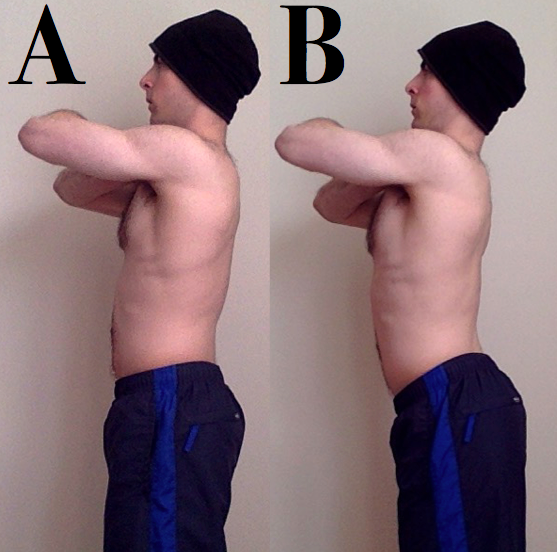
How Does a Weak Core Affect Anterior Pelvic Tilt?
There are a lot of different opinions on the cause of Anterior Pelvic Tilt. Some people make it way too complicated and over indulge using big words and unnecessary explanations. One of those common arguments is whether or not a weak core has anything to do with Anterior Pelvic Tilt. I am here to say YES, yes it does.
BUT and that’s a big but.
It’s not just that your core is weak and needs “strengthening”.
I believe there are 3 aspects to the weak core dilemma that need to be addressed
1) Due to the APT, your core is more than likely turned off and you default to locking or bracing your stomach in extension rather than using your trunk to brace.
2) Your core doesn’t have the endurance it needs to maintain a neutral pelvis especially while you are in the stages of retraining your body to maintain a neutral pelvis. So, lets not think “strength” but instead think “endurance”.
3) Because of the above 2 things you really don’t know how to use your core to brace the way you should (with a neutral spine and pelvis) while doing daily activities or exercises in the gym.
How do you fix Anterior Pelvic Tilt?
**Scroll to the bottom to print off your free APT Repair Guide.**
Alright, so on to my favorite part, the action phase!
The key areas I am going to focus on in this section are the stretches, exercises and tissue release techniques needed to reverse APT along developing the habits necessary to never deal with this again.
This section is video heavy so take it one at a time and be sure to reference this section if you need to for the APT Fix program you will be able to print off at the end of this article.
Let’s start with the stretching and tissue release.
Rectus Femoris
Hip Flexors
Core exercises that help fix Anterior Pelvic Tilt
Dead Bugs
Band holds
Glute Activation Exercises
Stability Ball Hamstring Curl
Single Leg Hip Thrusts
Double Leg Hip Thrusts
Free Printable Anterior Pelvic Tilt Rehab Program
Click the image to have it sent right to you!
Be sure to share this post with a friend who you think would benefit! Share the wealth!
If you find yourself sitting often and experience a lot of lower back pain and tightness I would highly suggest you go through these simple steps to diagnosing yourself. The big takeaway with today’s post is to work both the front of the body and back when your trying to fix this APT issue. It will take time so commit to this program for at least 6 weeks and see how you are improving. Keep in mind that as you work to correct this issue, you have to also work to correct your sitting and standing posture. Actively engage the glutes and brace the trunk while you stand and sit. Stretching and strengthening is pointless if you don’t address the positions you are in that are causing the APT!.
Thanks for reading guys!
If you know anyone who has this problem be sure to share this article with them!
William
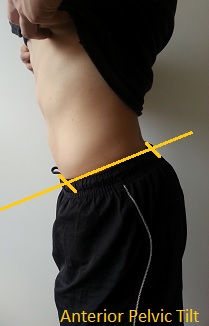
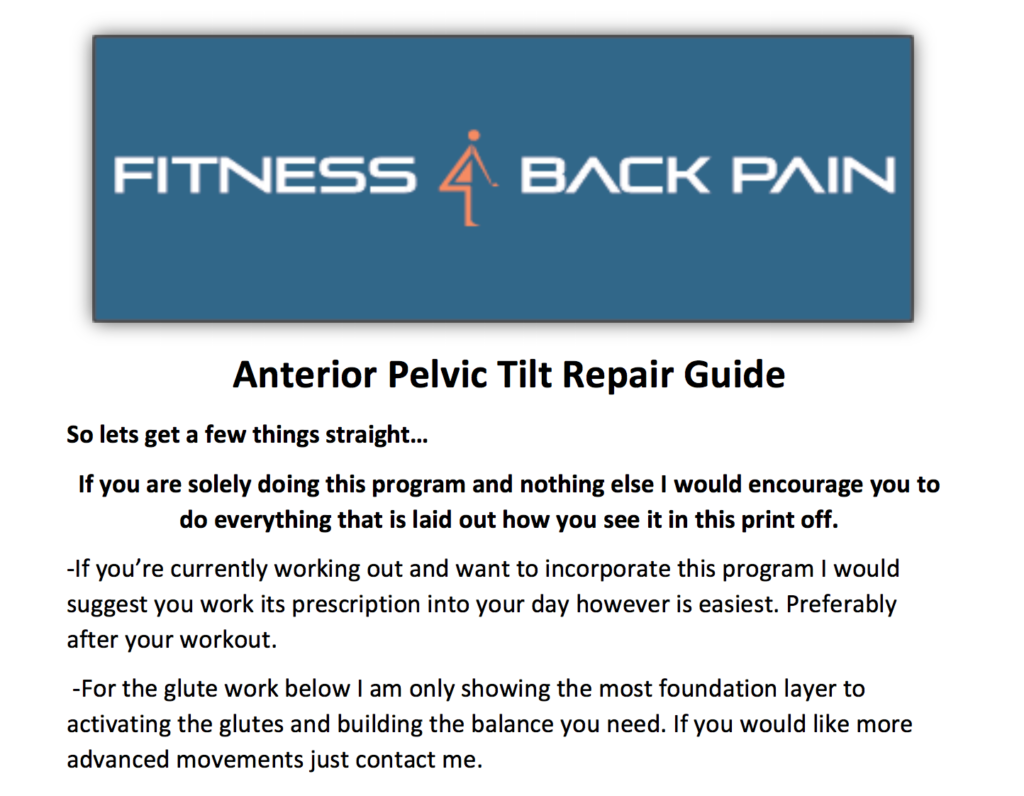

Great article
Have you ever heard of ATP causing pain in the Piriformis ?
I have personally not heard of anyone being able to diagnose that as the cause simply because it would be really hard to know if that is truly the cause. The Piriformis responds by tightening for a lot of different reasons.
Can’t thank you enough for your post. I have serious anterior pelvic tilt and I’ve been trying to fixing the issue for a month now. It seems like my posture has been improved when I’m standing but I found another issue I have.
When I walk, my pelvis twists side to side. I step forward with my left leg and taking the whole left side of my pelvis forward too and vice verse with the right leg. I twist my pelvis constantly when you see from the back.
Also my posture collapse especially when I walk. I videotaped my walking and my belly sticks out and my lower back is arched.
I can’t find any information about this walking issue. Is it also a cause of APT? Do you have any ideas please?
Joe, Thanks so much for your comment! This sounds more like a bad habit being grooved over a lifetime of walking. We develop walking and gait patterns on our own (for the most part). So with time, they can be reversed and new patterns can be made. For starters, I would add in what I call “conscious walking”. This is where you are taking all of your energy and focus and targeting your gait pattern. Reposition the pelvis into neutral and take your first step. Look down and see where your hips are. Are they excessively twisted? Reposition and take the second step. Keep repeating this day after day and learn to know what it “feels” like to be in a good position.
After a few weeks/months of this, you can start adding load to these new patterns to test the ability to maintain the position.
Hi, William,
I’m currently working on a paper required at The Ohio State University, The Anatomy of Clarinet Playing. Your article on Anterior Pelvic Tilt is awesome! Would it be possible to get permission to use some of your illustrations in my paper? They really illustrate some of the points I am making in the section on posture.
THX
Sure
Great article ! I started doing the program for my rounded shoulders and my APT.
Just a question on the band holds, the video is no longer available, not sure what exercise I should be doing (lots of videos calls band holds with very different exercises on YT)
Thanks!
Hey Adrien!
Thanks for the reminder on that broken link! I put up a similar one with the dead bug still being incorporated. You can simplify this exercise by just doing small “McGill Crunches” and holding at the top instead of the full leg movements.
What kind of foam roller are you using?
Hey, Angela!
I use a medical grade foam roller. it holds up to wear and tear a lot easier. This is my affiliate link to the product. This is what I use
Great information, really appreciated! Quick question for you, so I am continuing with a lifting program on top of doing your anterior pelvic tilt fix, question is would I continue to do quad and hamstring lifts? I know that my hamstrings are very weak compared to my quads. Should I omit doing quad lifts, and would it benefit to do hamstring lifts a few times a week as well (ie hamstring curls) thanks
Hey Brian!
That’s exactly what I would do for now. I did this very thing and still try to keep hamstrings a priority over quads since I have spent most my lifting career doing the opposite.
Any tips on sitting posture would be great, I feel I know how to correct it standing but struggle sitting. I make sure I take regularl breaks to get up and stretch\change position
Thanks dude, he actually agrees. Tight hamstrings are an effect of my back pain, not the cause!
I’ve got a 6 week core strengthening programe targeting my glutes and adominals that are very switched off.
I’m complementing that with your apt stretches and posture focus, in particular when washing up! Great tips, keep it up.
(Just got a foam roller yesterday!)
Awesome! Would love to see what he has you on! I do have some sitting mechanics that you can use I am doing a write up here soon on that so Ill be sure to make sure you see it when its done.
Hey William thank you for such a comprehensive guide I will be printing in this off to show to my Physio. hhe pointed out the other day I do have a pelvic tilt and I have very tight hamstrings and tight erector spinae but he wants me to stretch and its just getting me nowhere. I feel the key is to strengthen other muscles relax other muscles to take the pressure off these overly high muscles I don’t see how stretching my erector spinae is going to help me already feels super tight
Hey Matthew!
Thank for reading dude!
Yeah, I know from personal experience stretching my erectors only caused more tightness and irritation. I had to spend a lot of time fixing my daily habits first like the way I would sit, stand and bend which lead to the muscles being able to relax and release. That’s when the APT focus work really was able to help. It’s still a work in progress but I know I am on the right track.
All the respect in the world to your physio but he is a person just like you and me. If you do the research and feel you need to take another approach don’t hesitate to take your relief into your own hands.